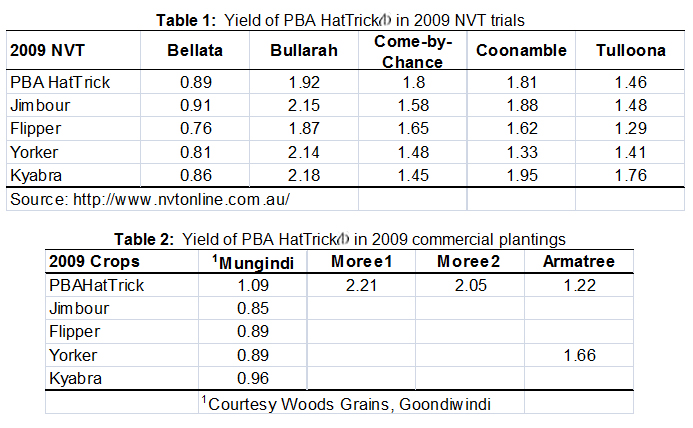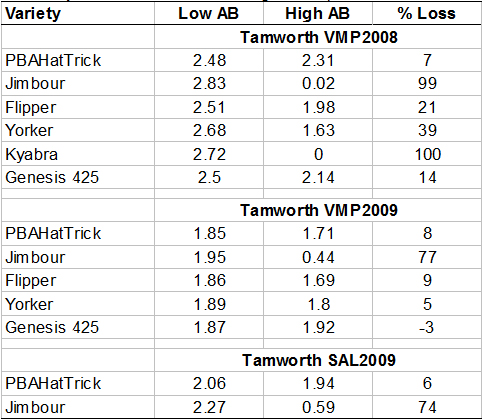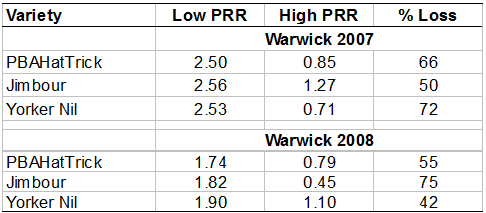Chickpeas In 2010: PBA Hattrick - Performance And Management
| Date: 11 May 2010

Kevin Moore1, Ted Knights1, Paul Nash1, Gail Chiplin1 and Mal Ryley2
1NSWI&I, Tamworth and 2DEEDI, Toowoomba
Take home message
· PBA HatTrick performed well in 2009 with commercial yields of 1.0 to 2.2 t/ha
performed well in 2009 with commercial yields of 1.0 to 2.2 t/ha
 performed well in 2009 with commercial yields of 1.0 to 2.2 t/ha
performed well in 2009 with commercial yields of 1.0 to 2.2 t/ha· HatTrick’s Ascochyta rating (MR/R) was confirmed in 2009 trials at Tamworth
Ascochyta rating (MR/R) was confirmed in 2009 trials at Tamworth
 Ascochyta rating (MR/R) was confirmed in 2009 trials at Tamworth
Ascochyta rating (MR/R) was confirmed in 2009 trials at Tamworth· There is no cost benefit in spraying HatTrick for Ascochyta until the disease is found
for Ascochyta until the disease is found
 for Ascochyta until the disease is found
for Ascochyta until the disease is found· Crop Care Barrack720® (chlorothalonil) is now registered for ascochyta in chickpea
· HatTrick’s Phytophthora rating (MR) was confirmed in 2009 trials at Tamworth & Warwick
Phytophthora rating (MR) was confirmed in 2009 trials at Tamworth & Warwick
 Phytophthora rating (MR) was confirmed in 2009 trials at Tamworth & Warwick
Phytophthora rating (MR) was confirmed in 2009 trials at Tamworth & Warwick· Agronomically, manage HatTrick the way you would Jimbour
the way you would Jimbour
 the way you would Jimbour
the way you would Jimbour
How did PBA HatTrick perform in 2009?
Only small areas of PBA HatTrick were grown commercially throughout the GRDC northern region in 2009 and growers were happy with its performance. In a few districts, yields of HatTrick
were grown commercially throughout the GRDC northern region in 2009 and growers were happy with its performance. In a few districts, yields of HatTrick and other varieties were reduced by low temperatures and frosts during flowering and pod fill. Like any new variety, HatTrick’s
and other varieties were reduced by low temperatures and frosts during flowering and pod fill. Like any new variety, HatTrick’s place in northern farming systems will require several seasons’ evaluation. The following yields should be considered in that context.
place in northern farming systems will require several seasons’ evaluation. The following yields should be considered in that context.
 were grown commercially throughout the GRDC northern region in 2009 and growers were happy with its performance. In a few districts, yields of HatTrick
were grown commercially throughout the GRDC northern region in 2009 and growers were happy with its performance. In a few districts, yields of HatTrick and other varieties were reduced by low temperatures and frosts during flowering and pod fill. Like any new variety, HatTrick’s
and other varieties were reduced by low temperatures and frosts during flowering and pod fill. Like any new variety, HatTrick’s place in northern farming systems will require several seasons’ evaluation. The following yields should be considered in that context.
place in northern farming systems will require several seasons’ evaluation. The following yields should be considered in that context.Mungindi was sown 14 May 09. Moree1 was sown 4 May 09 and sustained some low temperature and frost damage. Moree2 was sown 1st week June. The grower at Armatree planted Yorker on 11 May 09 and HatTrick on 18 May. When inspected on 10 Sep 09, the HatTrick
on 18 May. When inspected on 10 Sep 09, the HatTrick had 2-3 pods (3 pods where the crop was moisture stressed) compared with 0-1 pods in the Yorker
had 2-3 pods (3 pods where the crop was moisture stressed) compared with 0-1 pods in the Yorker . In this particular case, HatTrick’s
. In this particular case, HatTrick’s quicker development (10 days earlier to flower) contributed to its lower yield – flowers and pods aborted by low temperatures, estimated by the grower to have reduced yield by 30%.
quicker development (10 days earlier to flower) contributed to its lower yield – flowers and pods aborted by low temperatures, estimated by the grower to have reduced yield by 30%.
 on 18 May. When inspected on 10 Sep 09, the HatTrick
on 18 May. When inspected on 10 Sep 09, the HatTrick had 2-3 pods (3 pods where the crop was moisture stressed) compared with 0-1 pods in the Yorker
had 2-3 pods (3 pods where the crop was moisture stressed) compared with 0-1 pods in the Yorker . In this particular case, HatTrick’s
. In this particular case, HatTrick’s quicker development (10 days earlier to flower) contributed to its lower yield – flowers and pods aborted by low temperatures, estimated by the grower to have reduced yield by 30%.
quicker development (10 days earlier to flower) contributed to its lower yield – flowers and pods aborted by low temperatures, estimated by the grower to have reduced yield by 30%. PBA HatTrick’s disease package
HatTrick’s parents are Jimbour
parents are Jimbour and an ascochyta resistant Iranian line, so basically it is an Ascochyta resistant Jimbour
and an ascochyta resistant Iranian line, so basically it is an Ascochyta resistant Jimbour . Five trials conducted at Tamworth since 2006 have demonstrated HatTrick’s
. Five trials conducted at Tamworth since 2006 have demonstrated HatTrick’s outstanding resistance to ascochyta, significantly better than Flipper
outstanding resistance to ascochyta, significantly better than Flipper . This means in most seasons HatTrick
. This means in most seasons HatTrick will require no ascochyta fungicide sprays. However, in situations where your neighbours are growing an ascochyta susceptible variety and are not adequately managing the disease, spraying HatTrick
will require no ascochyta fungicide sprays. However, in situations where your neighbours are growing an ascochyta susceptible variety and are not adequately managing the disease, spraying HatTrick may be warranted especially at podding. HatTrick
may be warranted especially at podding. HatTrick also has useful resistance to phytophthora root rot. Three trials conducted at Warwick since 2007 have confirmed HatTrick’s
also has useful resistance to phytophthora root rot. Three trials conducted at Warwick since 2007 have confirmed HatTrick’s moderate resistance to phytophthora, as good as or slightly better than Jimbour
moderate resistance to phytophthora, as good as or slightly better than Jimbour but not quite as good as Yorker
but not quite as good as Yorker . HatTrick’s
. HatTrick’s virus rating is similar to Jimbour
virus rating is similar to Jimbour i.e. susceptible. Its root lesion nematode ratings are unknown, but are assumed to be similar to Jimbour i.e. susceptible.
i.e. susceptible. Its root lesion nematode ratings are unknown, but are assumed to be similar to Jimbour i.e. susceptible.
 parents are Jimbour
parents are Jimbour and an ascochyta resistant Iranian line, so basically it is an Ascochyta resistant Jimbour
and an ascochyta resistant Iranian line, so basically it is an Ascochyta resistant Jimbour . Five trials conducted at Tamworth since 2006 have demonstrated HatTrick’s
. Five trials conducted at Tamworth since 2006 have demonstrated HatTrick’s outstanding resistance to ascochyta, significantly better than Flipper
outstanding resistance to ascochyta, significantly better than Flipper . This means in most seasons HatTrick
. This means in most seasons HatTrick will require no ascochyta fungicide sprays. However, in situations where your neighbours are growing an ascochyta susceptible variety and are not adequately managing the disease, spraying HatTrick
will require no ascochyta fungicide sprays. However, in situations where your neighbours are growing an ascochyta susceptible variety and are not adequately managing the disease, spraying HatTrick may be warranted especially at podding. HatTrick
may be warranted especially at podding. HatTrick also has useful resistance to phytophthora root rot. Three trials conducted at Warwick since 2007 have confirmed HatTrick’s
also has useful resistance to phytophthora root rot. Three trials conducted at Warwick since 2007 have confirmed HatTrick’s moderate resistance to phytophthora, as good as or slightly better than Jimbour
moderate resistance to phytophthora, as good as or slightly better than Jimbour but not quite as good as Yorker
but not quite as good as Yorker . HatTrick’s
. HatTrick’s virus rating is similar to Jimbour
virus rating is similar to Jimbour i.e. susceptible. Its root lesion nematode ratings are unknown, but are assumed to be similar to Jimbour i.e. susceptible.
i.e. susceptible. Its root lesion nematode ratings are unknown, but are assumed to be similar to Jimbour i.e. susceptible.
Table 3: Chickpea yields in 2008 and 2009 Ascochyta blight, AB management trials at Tamworth. Trials were inoculated with Ascochyta at the 6-7 leaf stage. Low AB plots received chlorothalonil sprays before rain; High AB plots were unprotected. The % Yield loss is the difference in yield between Low AB & High AB expressed as a % of Low AB yield.
In both seasons the difference in grain yield for HatTrick between Low and High AB was not significant. In contrast, Jimbour
between Low and High AB was not significant. In contrast, Jimbour sustained 99% loss in 2008 and 75-76% in 2009. The other varieties performed as expected.
sustained 99% loss in 2008 and 75-76% in 2009. The other varieties performed as expected.
 between Low and High AB was not significant. In contrast, Jimbour
between Low and High AB was not significant. In contrast, Jimbour sustained 99% loss in 2008 and 75-76% in 2009. The other varieties performed as expected.
sustained 99% loss in 2008 and 75-76% in 2009. The other varieties performed as expected.
Table 4: Chickpea yields in 2007 and 2008 phytophthora root rot, PRR yield loss trials at Warwick, QLD. Trials were inoculated with phytophthora at sowing. Low PRR plots received metalaxyl seed treatment plus regular soil drenches with metalaxyl. High PRR plots received neither seed treatment nor soil drench. The % yield loss is the difference in yield between Low PRR & High PRR expressed as a % of Low PRR yield.
In spite of discrepancies between 2007 and 2008, the results confirm that HatTrick has useful (but by no means complete) resistance to phytophthora. In earlier trials with a highly susceptible variety, Sonali, yield loss was 100% in plots not protected with metalaxyl. Survival data from our 2009 Warwick PRR trial (yield date not yet available) confirm the 2008 finding that Yorker
has useful (but by no means complete) resistance to phytophthora. In earlier trials with a highly susceptible variety, Sonali, yield loss was 100% in plots not protected with metalaxyl. Survival data from our 2009 Warwick PRR trial (yield date not yet available) confirm the 2008 finding that Yorker >HatTrick
>HatTrick >Jimbour
>Jimbour .
.
 has useful (but by no means complete) resistance to phytophthora. In earlier trials with a highly susceptible variety, Sonali, yield loss was 100% in plots not protected with metalaxyl. Survival data from our 2009 Warwick PRR trial (yield date not yet available) confirm the 2008 finding that Yorker
has useful (but by no means complete) resistance to phytophthora. In earlier trials with a highly susceptible variety, Sonali, yield loss was 100% in plots not protected with metalaxyl. Survival data from our 2009 Warwick PRR trial (yield date not yet available) confirm the 2008 finding that Yorker >HatTrick
>HatTrick >Jimbour
>Jimbour .
.Management of HatTrickin 2010
HatTrick is seen as a replacement for Jimbour
is seen as a replacement for Jimbour . Its fit and management in the farming system are thus the same as Jimbour
. Its fit and management in the farming system are thus the same as Jimbour (with the exception of ascochyta management). Like all current chickpea varieties HatTrick
(with the exception of ascochyta management). Like all current chickpea varieties HatTrick is sensitive to herbicide injury. Pay particular attention to herbicide residues from previous crops and remember that plant back periods start from the time the rainfall requirement is met, not from the time the herbicide was applied. Be careful with triazines especially when double cropping after sorghum and be aware that some Group I herbicides can persist on cereal stubble.
is sensitive to herbicide injury. Pay particular attention to herbicide residues from previous crops and remember that plant back periods start from the time the rainfall requirement is met, not from the time the herbicide was applied. Be careful with triazines especially when double cropping after sorghum and be aware that some Group I herbicides can persist on cereal stubble.
 is seen as a replacement for Jimbour
is seen as a replacement for Jimbour . Its fit and management in the farming system are thus the same as Jimbour
. Its fit and management in the farming system are thus the same as Jimbour (with the exception of ascochyta management). Like all current chickpea varieties HatTrick
(with the exception of ascochyta management). Like all current chickpea varieties HatTrick is sensitive to herbicide injury. Pay particular attention to herbicide residues from previous crops and remember that plant back periods start from the time the rainfall requirement is met, not from the time the herbicide was applied. Be careful with triazines especially when double cropping after sorghum and be aware that some Group I herbicides can persist on cereal stubble.
is sensitive to herbicide injury. Pay particular attention to herbicide residues from previous crops and remember that plant back periods start from the time the rainfall requirement is met, not from the time the herbicide was applied. Be careful with triazines especially when double cropping after sorghum and be aware that some Group I herbicides can persist on cereal stubble.For specific information on agronomic management, consult HatTrick’s VMP available at http://www.pulseaus.com.au/pdf/PBA%20HatTrick%20VMP.pdf, and the DPI Winter Crop Variety Sowing Guide, WCVSG available at http://www.dpi.nsw.gov.au/agriculture/field/field-crops/winter-cereals/guides/winter-crop-variety-sowing-guide.
VMP available at http://www.pulseaus.com.au/pdf/PBA%20HatTrick%20VMP.pdf, and the DPI Winter Crop Variety Sowing Guide, WCVSG available at http://www.dpi.nsw.gov.au/agriculture/field/field-crops/winter-cereals/guides/winter-crop-variety-sowing-guide.
 VMP available at http://www.pulseaus.com.au/pdf/PBA%20HatTrick%20VMP.pdf, and the DPI Winter Crop Variety Sowing Guide, WCVSG available at http://www.dpi.nsw.gov.au/agriculture/field/field-crops/winter-cereals/guides/winter-crop-variety-sowing-guide.
VMP available at http://www.pulseaus.com.au/pdf/PBA%20HatTrick%20VMP.pdf, and the DPI Winter Crop Variety Sowing Guide, WCVSG available at http://www.dpi.nsw.gov.au/agriculture/field/field-crops/winter-cereals/guides/winter-crop-variety-sowing-guide.PBA HatTrick’s MR/R rating for Ascochyta does not mean the disease poses no threat to HatTrick
MR/R rating for Ascochyta does not mean the disease poses no threat to HatTrick . Indeed, in 2008, we saw the consequences of complacency when ascochyta caused widespread damage even in the MR rated Flipper
. Indeed, in 2008, we saw the consequences of complacency when ascochyta caused widespread damage even in the MR rated Flipper . Follow the general disease management recommendations for chickpeas in the WCVSG and at http://www.pulseaus.com.au/pdf/Chickpea%20Disease%20Management%20Strategy%20-%20Northern%20Region%20A4.pdf
. Follow the general disease management recommendations for chickpeas in the WCVSG and at http://www.pulseaus.com.au/pdf/Chickpea%20Disease%20Management%20Strategy%20-%20Northern%20Region%20A4.pdf
 MR/R rating for Ascochyta does not mean the disease poses no threat to HatTrick
MR/R rating for Ascochyta does not mean the disease poses no threat to HatTrick . Indeed, in 2008, we saw the consequences of complacency when ascochyta caused widespread damage even in the MR rated Flipper
. Indeed, in 2008, we saw the consequences of complacency when ascochyta caused widespread damage even in the MR rated Flipper . Follow the general disease management recommendations for chickpeas in the WCVSG and at http://www.pulseaus.com.au/pdf/Chickpea%20Disease%20Management%20Strategy%20-%20Northern%20Region%20A4.pdf
. Follow the general disease management recommendations for chickpeas in the WCVSG and at http://www.pulseaus.com.au/pdf/Chickpea%20Disease%20Management%20Strategy%20-%20Northern%20Region%20A4.pdfConclusions
PBA HatTrick performed well in 2009 and is well worth evaluating in 2010. Agronomically, manage HatTrick
performed well in 2009 and is well worth evaluating in 2010. Agronomically, manage HatTrick as you would Jimbour
as you would Jimbour . Follow general disease recommendations (consult VMP for specific recommendations). Do not be complacent about Ascochyta.
. Follow general disease recommendations (consult VMP for specific recommendations). Do not be complacent about Ascochyta.
 performed well in 2009 and is well worth evaluating in 2010. Agronomically, manage HatTrick
performed well in 2009 and is well worth evaluating in 2010. Agronomically, manage HatTrick as you would Jimbour
as you would Jimbour . Follow general disease recommendations (consult VMP for specific recommendations). Do not be complacent about Ascochyta.
. Follow general disease recommendations (consult VMP for specific recommendations). Do not be complacent about Ascochyta.Acknowledgements
Thanks to Willy Martin, Kris King and Lisa Keller, DEEDI for help with the PRR work.
Contact details
Kevin Moore, NSW Department Industry & Investment
Tamworth Agricultural Institute, 4 Marsden Park Rd, Calala, NSW, 2340
Was this page helpful?
YOUR FEEDBACK
To protect your privacy, please do not include contact information in your feedback. If you would like
a response, please contact us.
